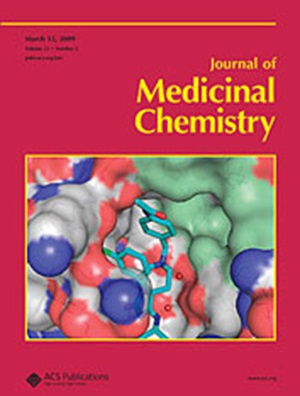Fluorescence-Coupled Ubiquitination Assay as a High-Throughput Screening Strategy for Novel Cereblon Degraders
IF 6.8
1区 医学
Q1 CHEMISTRY, MEDICINAL
引用次数: 0
Abstract
Cereblon (CRBN)-based protein degradation, via molecular glue degraders (MGDs) and proteolysis-targeting chimeras (PROTACs), is a promising cancer treatment strategy in targeted protein degradation (TPD). However, novel degraders discovery remains limited due to the lack of robust, high-throughput screening (HTS) methods for processing pools of purified compounds or complex chemical synthesis mixtures. Here, we introduce an innovative HTS strategy that employs a highly sensitive, fluorescence-coupled ubiquitination assay to identify CRBN-based degraders. This approach tracks ubiquitinated target proteins via gel-based analyses, and thereby progressively narrows down the list of potential degrader molecules from large-scale compound libraries or chemical reaction mixtures. Using this strategy, we identified LL-BPTF-8, a promising lead compound of PROTAC degrader with high potency and selectivity that targets the bromodomain PHD finger transcription factor (BPTF). Overall, our method offers a low-cost, rapid, and versatile platform for the HTS of protein degrader candidates, significantly streamlining the discovery of novel degraders.荧光偶联泛素化试验作为新型小脑降解物的高通量筛选策略
基于小脑(CRBN)的蛋白质降解,通过分子胶降解剂(MGDs)和蛋白水解靶向嵌合体(PROTACs),是一种很有前途的靶向蛋白质降解(TPD)癌症治疗策略。然而,由于缺乏用于纯化化合物或复杂化学合成混合物处理池的强大的高通量筛选(HTS)方法,新型降解剂的发现仍然有限。在这里,我们介绍了一种创新的HTS策略,该策略采用高灵敏度,荧光偶联泛素化测定来鉴定基于crbn的降解物。这种方法通过凝胶分析来追踪泛素化的靶蛋白,从而逐步缩小大规模化合物文库或化学反应混合物中潜在降解分子的范围。利用这一策略,我们鉴定出了一种靶向bromodomain PHD手指转录因子(BPTF)的具有高效和选择性的PROTAC降解先导化合物LL-BPTF-8。总的来说,我们的方法为候选蛋白质降解物的HTS提供了一个低成本、快速和通用的平台,大大简化了新型降解物的发现。
本文章由计算机程序翻译,如有差异,请以英文原文为准。
求助全文
约1分钟内获得全文
求助全文
来源期刊

Journal of Medicinal Chemistry
医学-医药化学
CiteScore
4.00
自引率
11.00%
发文量
804
审稿时长
1.9 months
期刊介绍:
The Journal of Medicinal Chemistry is a prestigious biweekly peer-reviewed publication that focuses on the multifaceted field of medicinal chemistry. Since its inception in 1959 as the Journal of Medicinal and Pharmaceutical Chemistry, it has evolved to become a cornerstone in the dissemination of research findings related to the design, synthesis, and development of therapeutic agents.
The Journal of Medicinal Chemistry is recognized for its significant impact in the scientific community, as evidenced by its 2022 impact factor of 7.3. This metric reflects the journal's influence and the importance of its content in shaping the future of drug discovery and development. The journal serves as a vital resource for chemists, pharmacologists, and other researchers interested in the molecular mechanisms of drug action and the optimization of therapeutic compounds.
 求助内容:
求助内容: 应助结果提醒方式:
应助结果提醒方式:


